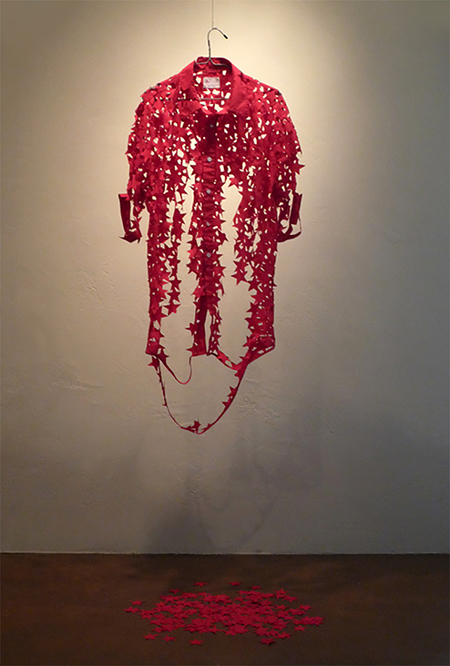
Continuing through March 28, 2021 (Covid-19 safety protocols observed in accord with CDC and State health department guidelines)
A red food worker’s shirt bearing star-shaped holes hangs near the gallery entrance, with red fabric stars strewn beneath it. Ann Morton’s 2009 work, titled “Losing Our Shirt,” signals the many ways this artist elevates what’s missing in contemporary life, from economic justice to gender equality. Curiosity about what the stars might symbolize prompts us to move through the space while considering essential questions: What holes exist in contemporary society? Why do they exist? And what responsibility do we have, as individuals and communities, to repair them?
It’s a common thread in much of her work, created using primarily textiles and found objects. The exhibit highlights two key themes present in her body of work, spanning 2006 to 2020: politics and race relations. Collectively, they remind us that trauma fueled by recent police brutality, a raging pandemic and political propaganda has historical antecedents that continue to reverberate in the absence of systemic change.
At the center of the gallery, a chair with custom jacquard weaving (“The Seat of Secret Society,” 2008) appears perfectly ordinary from afar, but becomes more foreboding once its pattern comes into clearer focus. The design includes groups of swarming roaches. Atop the chair, there’s a white doily that speaks to the ways violent actions were obfuscated by the George W. Bush administration. A woven rectangular work anchored by the iconic image of Lucille Ball, surrounded by flying bombs and a wartime aircraft, hangs nearby (“Shock & Awe of an American Baby Boomer,” 2007).
The artist also critiques decisions made by Barack Obama, using a set of samplers (“Samplers,” 2013) that reference key moments in his term. Five white handkerchiefs hang along the same wall, each featuring text in red and blue embroidery that twists words uttered by Donald Trump on topics ranging from immigration to mainstream media (“Proofreading,” 2017-2020). Her use of soft materials and relatively subdued color palettes create an initial sense of calm, but fuels greater reflection that effectively fuels deep emotions from anger to grief. The approach is particularly effective with "Original Sin” (2020), a piece that includes bars of white soap carved with the image of Jesus. They’re set below a portrait of Jesus that was prevalent in Christian households during the mid-20th century, a fact that amplifies the way Morton’s work channels her own experiences growing up in a country steeped in white privilege.
The artist called on her own experiences as a woman in “When I’m 64” (2018), consisting of 64 speculums, red wool yarn, cherry pits, lead shot and a steel hoop. The installation references changes to the female body and psyche over time, and the ways society expects women to jump through hoops while sublimating their own selfhood.
The retrospective also highlights several works created in collaboration with community members and large-scale public artworks addressing issues related to personal and communal responsibility, including homelessness and recycling. Two large quilts made with clothing discarded at a human services campus hang side by side, each with the face of a homeless person (“Josef” and “Michelle,” 2014-2015). A panel hangs from ceiling to floor, formed by sewing together works made by people around the country for a project called “The Violet Protest” [discussed in an earlier article by Trimble, https://www.visualartsource.com/index.php?page=editorial&pcID=27&aID=5659] Later this year, she’ll send squares to every member of Congress, hoping their combined red and blue imagery will inspire the legislators to avoid the us-versus-them mentality. During a time of political, social and cultural upheaval. It’s a poignant reminder of the responsibility we all bear for co-creating and sustaining a just society.
